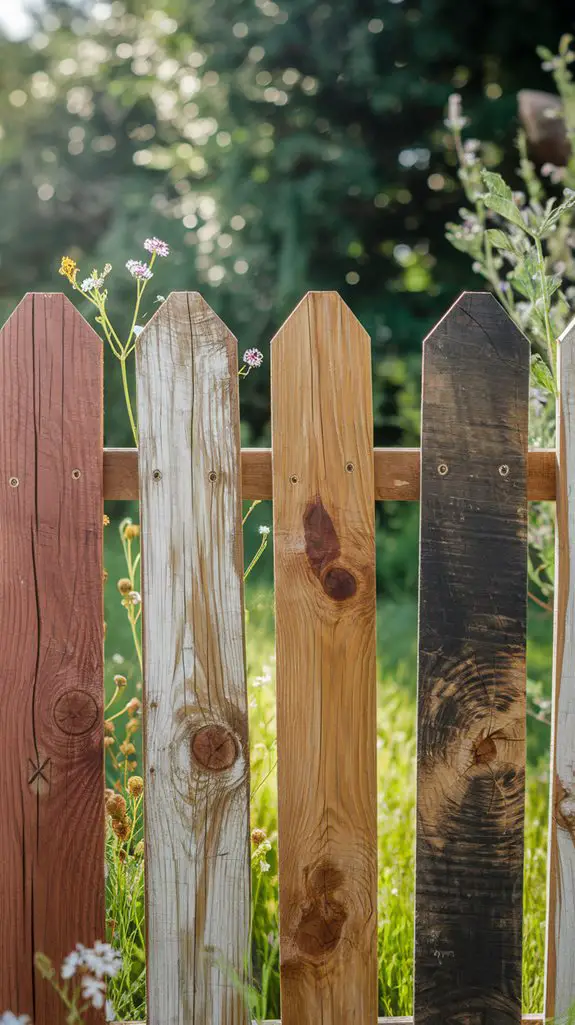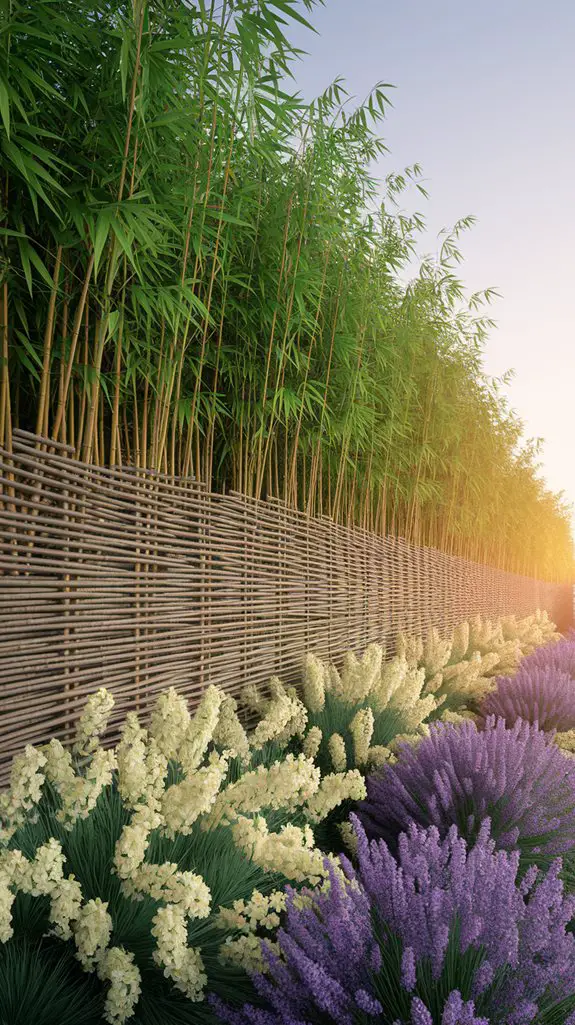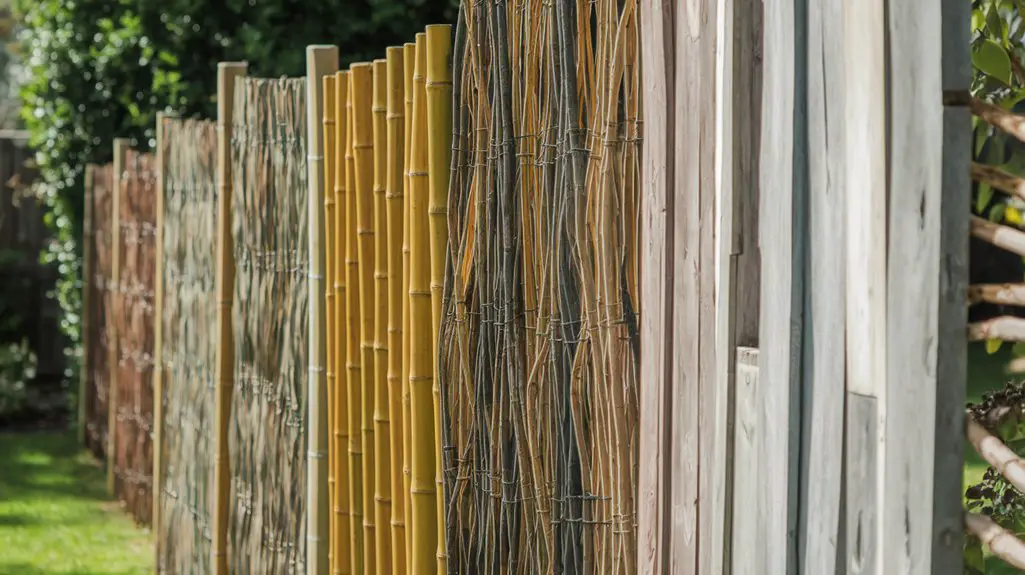Did you know that standard fence manufacturing contributes over 30 million tons of waste to landfills annually? Your choice of fencing materials can dramatically reduce this environmental impact while creating a boundary that works with nature rather than against it. From rapidly renewable bamboo to living barriers that support local wildlife, your options extend far beyond conventional wood and vinyl. Let’s explore how your fence can become an asset to the planet instead of a burden.
Bamboo: The Renewable Fencing Wonder
When considering sustainable fencing options, bamboo stands out as a remarkable choice with its unparalleled growth rate and versatility. Unlike traditional wood that takes decades to mature, bamboo reaches harvest-ready size in just 3-5 years while absorbing 35% more carbon dioxide than equivalent trees.
You’ll find bamboo fencing available in various styles, from rolled panels to structured posts. It’s naturally resistant to pests and weathering, eliminating the need for toxic preservatives that harm soil and water systems.
Properly harvested bamboo doesn’t require replanting as it regenerates from its extensive root system. For best results, look for FSC-certified bamboo to verify your fencing comes from responsibly managed sources. Additionally, bamboo is an excellent choice for eco-conscious homes, as it aligns with sustainable living practices.
With minimal processing requirements and biodegradable properties, bamboo represents a truly circular solution for your garden boundaries.
Reclaimed Wood and Repurposed Lumber Options

While bamboo offers exceptional sustainability features, reclaimed wood represents the ultimate form of material recycling for your fencing needs.
You’ll find this material brings character and history to your property while preventing perfectly usable timber from entering landfills. Sourcing options include old barns, factory demolitions, river-recovered logs, and urban tree removals.
- Each piece tells a unique story with its weathered patina and distinctive grain patterns
- Requires minimal additional processing, reducing your carbon footprint
- Naturally aged wood often possesses greater resistance to elements than new lumber
- Creates habitat niches for beneficial insects in its existing crevices and textures
- Supports local deconstruction businesses that prioritize material salvage over demolition
Consider mixing different reclaimed woods for a truly one-of-a-kind fence design.
Living Fences: Hedges and Plant Barriers

Living fences represent perhaps the most ecologically beneficial boundary solution for your property, as they transform a utilitarian structure into a thriving ecosystem. Unlike static fences, hedgerows and plant barriers grow stronger over time while providing habitat for birds, pollinators, and beneficial insects. Additionally, incorporating creative privacy screen ideas can enhance the aesthetic appeal of your living fence.
| Plant Type | Height Range | Best Uses |
|---|---|---|
| Privet | 4-15 ft | Privacy, wind break |
| Bamboo | 10-40 ft | Quick establishment |
| Osage Orange | 20-30 ft | Security barrier |
You’ll find that living fences require minimal processing energy compared to manufactured alternatives. Choose native species whenever possible to support local wildlife and reduce maintenance needs. For immediate results, consider fast-growing shrubs like arborvitae or combine slower-growing plants with temporary structures. With proper planning, your living fence will provide beauty, privacy, and ecological benefits for decades.
Sustainable Hardwoods: Responsible Timber Choices
Although traditional lumber fencing has fallen out of favor with many eco-conscious homeowners, responsibly harvested hardwoods still deserve consideration in your sustainable landscape plan.
When sourced from certified sustainable forestry operations, hardwoods offer durability and natural beauty without the environmental costs of manufactured alternatives.
Look for these sustainable timber options for your fencing project:
- Black locust – naturally rot-resistant without chemical treatments
- Western red cedar – locally harvested in North America with excellent weather resistance
- Reclaimed barn wood – gives new life to existing timber resources
- FSC-certified oak – harvested under strict environmental standards
- Thermally modified wood – heat-treated to increase durability without chemicals
Always verify timber sources through Forest Stewardship Council (FSC) or Programme for the Endorsement of Forest Certification (PEFC) certifications to guarantee you’re supporting responsible forest management. Additionally, using eco-friendly practices in your gardening approach can enhance the benefits of these sustainable materials.
Woven Willow and Natural Wattle Fencing
For centuries, traditional woven willow and wattle fencing has provided gardeners with beautiful, biodegradable boundaries that harmonize perfectly with natural landscapes.
These living fences create habitat for beneficial insects and small wildlife, enhancing your garden’s biodiversity.
You’ll find willow particularly sustainable—it grows rapidly and can be harvested annually without killing the parent plant.
When weaving your fence, use freshly cut, flexible stems that bend without breaking. For wattle fencing, intertwine thin branches between upright stakes for a rustic, permeable barrier.
Both options offer carbon sequestration benefits and will eventually decompose, returning nutrients to your soil.
Unlike treated lumber or vinyl, these natural barriers leave no toxic footprint.
They’re also remarkably adaptive to curved boundaries and uneven terrain, making them perfect for organic garden designs. Additionally, using low-maintenance pet-friendly yard solutions can further enhance your outdoor environment while being considerate of your furry friends.
Stone and Earth-Based Boundary Solutions
When seeking long-lasting natural boundaries, stone walls and earth berms offer exceptional durability while maintaining ecological integrity.
You’ll find these solutions integrate seamlessly into landscapes while providing microhabitats for beneficial insects, reptiles, and small mammals.
Dry-stacked stone walls require no cement, allowing for natural drainage and thermal mass benefits that moderate surrounding temperatures.
- Gabion walls combine local stones with wire cages, creating permeable boundaries that prevent erosion
- Living earth berms topped with native grasses create windbreaks and sound barriers
- Locally-sourced fieldstone reduces transportation emissions and preserves regional character
- Stone spiral walls maximize space for herb gardens while defining property edges
- Hugelkultur berms incorporate decaying wood beneath soil, improving fertility while marking boundaries
Incorporating eco-friendly materials into these structures can further enhance their sustainability and environmental benefits.
Cork and Composite Natural Materials
Why not explore the innovative world of cork and composite materials for your eco-friendly fencing solutions?
Cork, harvested sustainably from oak trees without cutting them down, offers natural water resistance and impressive durability while providing excellent insulation properties for your garden spaces.
Composite fencing blends reclaimed wood fibers with recycled plastics, creating a sturdy alternative that withstands weather extremes without requiring chemical treatments.
You’ll appreciate that these materials don’t leach toxins into soil and can be recycled at the end of their life cycle.
Both options contribute to carbon sequestration efforts while reducing demand for virgin timber. In addition, privacy fencing designs made from these materials can enhance both aesthetics and functionality of your outdoor spaces.
When selecting composite materials, look for those certified by environmental organizations to guarantee you’re truly investing in biodiversity protection and resource conservation for your boundary solutions.
Conclusion
By choosing these natural fencing materials, you’re not just building boundaries—you’re hitting two birds with one stone by enhancing your property while protecting our planet. Each option reduces your carbon footprint, supports biodiversity, and creates habitat corridors for local wildlife. Whether it’s bamboo’s rapid renewability or stone’s timeless durability, your eco-friendly fence becomes both a statement and solution for sustainable living.




